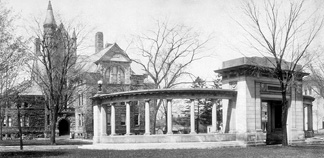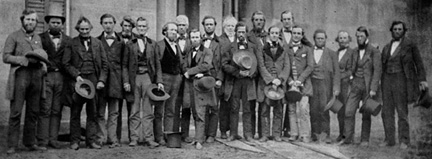Oberlin, Ohio
|
|
 |
Oberlin College |
Oberlin is governed by a city manager and a seven-member council which is elected to two-year terms in a non-partisan election. The current city manager is Robert DiSpirito.
| Contents |
History
Oberlin was founded in 1833 by two Presbyterian ministers, John Shipherd and Philo P. Stewart. The pair had become friends while spending the summer of 1832 together in nearby Elyria, Ohio and discovered a shared dissatisfaction with what they saw as the lack of strong Christian morals among the settlers of the American West. Their proposed solution was to create a religious community that would more closely adhere to Biblical commandments, along with a school for training Christian missionaries who would eventually spread out all over the American frontier. The two decided to name their community after Jean Frederic Oberlin (1740 - 1826), an Alsatian minister whose achievements had greatly impressed and inspired them.
Shipherd and Stewart rode south from Elyria into the forests that covered the northern part of Ohio in search of a suitable location for their community. After a journey of approximately eight miles, they stopped to rest and pray in the shade of an elm tree along the forest, and agreed that this would be a good place to start their community. Legend has it that while they prayed, a hunter saw a family of bears climb down from a nearby tree. The bears saw the two men, but turned away without harming them. On hearing this story from the hunter, the two ministers took it to be a sign from God that they had selected the right place for their community and school.
Shipherd travelled back East and convinced the owner of the land to donate 500 acres (2 km²) of land for the school, and he also purchased an additional 5000 acres (20 km²) for the town, at the cost of $1.50 per acre ($371/km²). While in that part of the country, he visited many of his friends and persuaded some to join in his adventure, and yet others to contribute money towards the construction of the community.
The motto of the new college was "Learning and Labor". In those days the words were taken quite literally: tuition at Oberlin College was free, but students were expected to contribute by helping to build and sustain the community. This attracted a number of bright young people who would otherwise not have been able to afford tuition. Eventually this approach was deemed inefficient; the motto, however, remains to this day.
Oberlin and slavery
Towards the middle of the 19th century, Oberlin became a major focus of the abolitionist movement in the United States. The town was conceived as an integrated community, and blacks had attended Oberlin College from its early years. Many Oberlin College graduates were dedicated abolitionists who traveled throughout the South working to help slaves escape to the north.
In 1834, in response to a series of slavery debates at Lane Theological Seminary, the trustees of the Cincinnati, Ohio school voted to prohibit antislavery agitation among its students and faculty. As a result, the "Lane Rebels," a group of about 50 students, trustee Asa Mahan, and professor John Morgan, left the school. Arthur Tappan, financial agent of the Oberlin Collegiate Institute, and co-founder John Shipherd saw an opportunity to solve Oberlin's financial problems by inviting the rebels (including Mahan and Morgan) to come to Oberlin. The rebels agreed under three conditions: that Oberlin accept students regardless of color, that Oberlin respect students' freedom of speech, and that Oberlin not "interfere with the internal regulation of the school." In the fall of 1835, Oberlin opened a new theology school with Asa Mahan as President, Charles Finney as Professor of theology, and the Lane Rebels among the first theology students.[1] (http://www.oberlin.edu/archive/resources/women/group11.html)
By 1852, the town of Oberlin was an active terminus on the underground railroad, and thousands had already passed through it on their way to freedom. This effort was assisted by an Ohio law that allowed fugitive slaves to apply for a writ of habeas corpus, which protected them from extradition back to the southern states from which they had escaped. In 1858, a newly-elected Democratic state legislature repealed this law, leaving the fugitives around Oberlin vulnerable to enforcement of the Federal Fugitive Slave Law, which allowed southern slave-catchers to target and extradite them back to the South.
This situation came to a head with the Oberlin-Wellington Rescue, a pivotal event, described in Nat Brandt's book "The Town That Started the Civil War." On September 13, 1858, a fugitive named John Price was captured and jailed in neighboring Wellington, Ohio. A large group of Oberlin residents consisting of townspeople, students and faculty, set out for the Wellington jail to release Price from captivity.
 |
Oberlin "Rescuers" outside the Cuyahoga County jail |
Price was freed and eventually smuggled out of the country, but the authorities were not content to let the matter rest. President James Buchanan personally requested that the group (now referred to by sympathetic parties as "the Rescuers") be prosecuted, and 37 of them were eventually tried and convicted by an all-Democrat jury. The group appealed to the Ohio Supreme Court for a writ of habeas corpus, but on May 30, 1859, their petition was denied. Ultimately, they bargained with the prosecutors, who granted the group their freedom in exchange for the promise that they would stay out of Northern Ohio.
The political ferment resulting from the case led to a number of major protests throughout the northern part of the state, and an unprecedented boost to the anti-slavery Republican party in the 1860 State elections. The governor of Ohio wrote to the new Republican President Abraham Lincoln urging him to repeal the Fugitive Slave Law. Though in point of fact, Lincoln declined this request, his decision did little to prevent a number of Southern states from seceding, and America was soon embroiled in the Civil War.
Geography
OHMap-doton-Oberlin.png
Location of Oberlin, Ohio
According to the United States Census Bureau, the city has a total area of 11.4 km² (4.4 mi²). 11.3 km² (4.4 mi²) of it is land and 0.1 km² (Less than 0.1 mi²) of it is water. The total area is 0.68% water.
Demographics
As of the censusTemplate:GR of 2000, there are 8,195 people, 2,678 households, and 1,395 families residing in the city. The population density is 722.4/km² (1,871.5/mi²). There are 2,836 housing units at an average density of 250.0/km² (647.7/mi²). The racial makeup of the city is 71.92% White, 18.55% African American, 0.49% Native American, 3.40% Asian, 0.17% Pacific Islander, 1.21% from other races, and 4.26% from two or more races. 3.04% of the population are Hispanic or Latino of any race.
There are 2,678 households out of which 21.4% have children under the age of 18 living with them, 38.5% are married couples living together, 11.5% have a female householder with no husband present, and 47.9% are non-families. 35.7% of all households are made up of individuals and 16.6% have someone living alone who is 65 years of age or older. The average household size is 2.31 and the average family size is 2.89.
In the city the population is spread out with 14.7% under the age of 18, 36.9% from 18 to 24, 16.4% from 25 to 44, 17.0% from 45 to 64, and 15.0% who are 65 years of age or older. The median age is 24 years. For every 100 females there are 77.7 males. For every 100 females age 18 and over, there are 73.2 males.
The median income for a household in the city is $41,094, and the median income for a family is $59,358. Males have a median income of $42,170 versus $27,308 for females. The per capita income for the city is $20,704. 19.4% of the population and 6.7% of families are below the poverty line. Out of the total population, 11.6% of those under the age of 18 and 7.5% of those 65 and older are living below the poverty line.
External links
- Oberlin Chamber of Commerce (http://www.oberlin.org)
- Oberlin College Website (http://www.oberlin.edu)
- History of the Oberlin College Rescue, compiled by Jacob R. Shipherd (from Library of Congress) (http://memory.loc.gov/cgi-bin/query/r?ammem/llst:@field(DOCID+@lit(llst005)):)
- Oberwiki (http://oberwiki.net/)
Further reading
- Brandt, Nat. The Town That Started the Civil War. Syracuse University Press, 1990. 315 p.
- Hart, Albert Bushnell, ed. The American Nation: a history from original sources. New York: Harper & Brothers, 1904-18.
